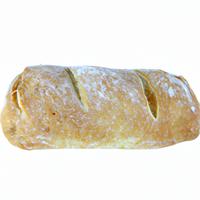
1 serving (100 grams) contains 271 calories, 9.0 grams of protein, 3.2 grams of fat, and 52.0 grams of carbohydrates.

Log this food in SnapCalorie

Nutrition Information
Calories |
677.5 | ||
|---|---|---|---|
% Daily Value* |
|||
| Total Fat | 8 g | 10% | |
| Saturated Fat | 1.2 g | 6% | |
| Polyunsaturated Fat | 0 g | ||
| Cholesterol | 0 mg | 0% | |
| Sodium | 1250 mg | 54% | |
| Total Carbohydrates | 130 g | 47% | |
| Dietary Fiber | 5.5 g | 19% | |
| Sugars | 3.5 g | ||
| protein | 22.5 g | 45% | |
| Vitamin D | 0 mcg | 0% | |
| Calcium | 50 mg | 3% | |
| Iron | 6.8 mg | 37% | |
| Potassium | 300 mg | 6% | |
* Percent Daily Values are based on a 2,000 calorie diet. Your daily values may be higher or lower depending on your calorie needs.
Food Attributes
Source of Calories
About Ciabatta bread roll
Ciabatta bread rolls are a classic Italian bread known for their rustic appearance and airy, chewy texture. Originating in Italy in the 1980s, "ciabatta" means "slipper" in reference to the bread's flat, elongated shape. These rolls are made from a simple mixture of wheat flour, water, yeast, olive oil, and salt, but their texture is achieved through high hydration dough and careful fermentation. Ciabatta is often enjoyed as a sandwich base or alongside soups and salads. Nutritionally, ciabatta provides carbohydrates for energy and a small amount of protein, though it is typically low in fiber due to the use of refined white flour. It contains minimal fat except for a mild contribution from olive oil. While not particularly nutrient-dense, ciabatta can be part of a balanced diet when paired with nutrient-rich toppings or complementary dishes.



